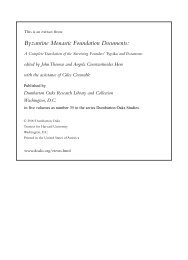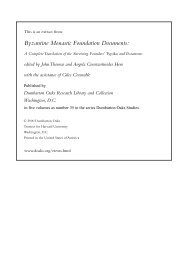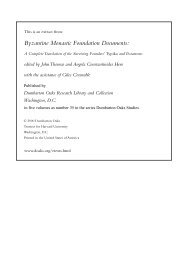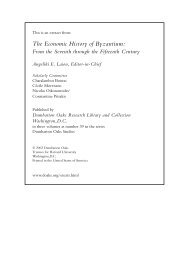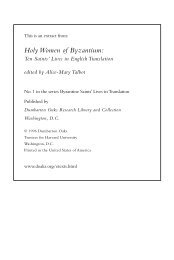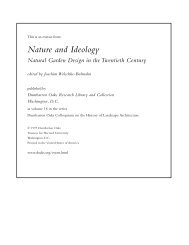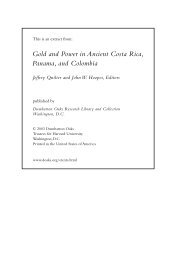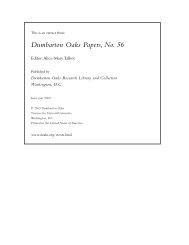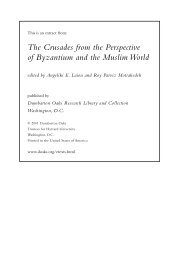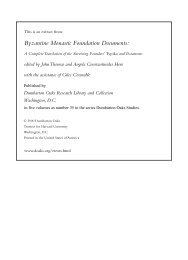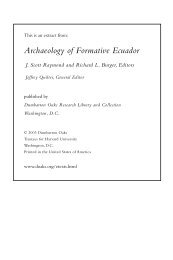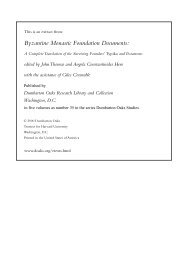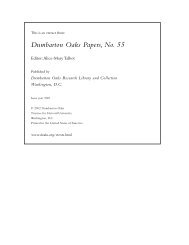22. Evergetis - Dumbarton Oaks
22. Evergetis - Dumbarton Oaks
22. Evergetis - Dumbarton Oaks
Create successful ePaper yourself
Turn your PDF publications into a flip-book with our unique Google optimized e-Paper software.
ELEVENTH CENTURY<br />
document, our manuscript copy of the founder’s typikon was not turned over to another institution<br />
until the sixteenth century. 27 Therefore it seems entirely possible that <strong>Evergetis</strong>, like the revived<br />
Stoudios monastery, survived down to the fall of the empire in 1453.<br />
No trace of the foundation remains on its presumed site near Tchirpedji-Dere or Hasnadar-<br />
Dere in an industrial district outside the old city walls in Istanbul. 28 Majeska (Russian Travelers,<br />
p. 316) suggests, however, that the existing Greek church of the Mother of God Gorgoepikoos<br />
may have been built in Ottoman times on the site of <strong>Evergetis</strong>’ Constantinopolitan dependency.<br />
Analysis<br />
This monastery was the leader of an enormously influential reform movement in Byzantine monasticism,<br />
29 which, building on both Basilian and Studite precedents, succeeded in revolutionizing<br />
contemporary attitudes on such important matters as the institutions of monastic governance,<br />
the abolition of privilege, strict financial management, and the desirability of the cenobitic life.<br />
The founder’s typikon is the fundamental text needed for understanding the nature of this reform.<br />
A. Lives of the Monks<br />
1. Number of Monks<br />
Unlike some earlier and contemporary documents, 30 the author of (22) <strong>Evergetis</strong> [23] declines to<br />
set a fixed number of positions for the monks in <strong>Evergetis</strong>, preferring to let the monastery’s resources<br />
determine the number who could be supported. A smaller number was acceptable too if it<br />
was not possible to recruit a full complement of pious monks. This too may have been a reform<br />
idea. The old notion of setting a fixed number of positions had the good intent of helping to assure<br />
that a foundation’s expenses did not exceed its available income (see above, Chapter Three, Concerns<br />
of the Authors), but in the era of the charistike must inevitably have led to situations like<br />
(21) Roidion in which unsuitable monks and even laymen were imposed on an institution simply<br />
because there were sufficient livings available to support them. To all appearances, however, the<br />
author anticipated that <strong>Evergetis</strong> would be a large foundation, judging from the need he saw [7]<br />
for the superior to appoint assistants to help him hear daily confessions and his expectation [36]<br />
that one day there would be too many deceased monks for them to be commemorated individually<br />
(see C.5 below).<br />
The monastic community at <strong>Evergetis</strong> was divided [7] into monks who lived continuously in<br />
the monastery (engaged in liturgical and other services) and an apparently larger number, including<br />
“the more uneducated majority,” who were assigned to various ministries both within and<br />
outside of the monastery. This division of the monastic community recalls the arrangements seen<br />
in (9) Galesios [182], which describes a foundation in which there were both choir monks and<br />
other mostly illiterate brothers.<br />
2. Liturgical Duties<br />
As in other documents that are part of the Studite liturgical tradition such as (4) Stoudios and (11)<br />
Ath. Rule, the celebration of the canonical hours [4], [5], [6] was an important part of the lives of<br />
the monks. Though the description of the hours is fuller than in the earlier documents, the author<br />
[ 458 ]




